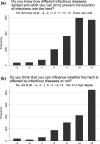Differing perceptions - Swedish farmers' views of infectious disease control
- PMID: 29067181
- PMCID: PMC5645822
- DOI: 10.1002/vms3.20
Differing perceptions - Swedish farmers' views of infectious disease control
Abstract
Although farm biosecurity reduces the risk of disease spread among livestock, this knowledge is not always applied. Farmers' application of disease preventive measures is expected to depend on many things, e.g. whether they consider disease prevention possible and demographic factors. In this study, Swedish livestock farmers' perspectives on occurrence, control and communication related to infectious livestock diseases were investigated. A questionnaire study was performed in 2012-2013, and included responses from almost 2000 livestock farmers with cattle, pigs, sheep or goats. Associations between responses and factors related to herd type and demography were investigated using multivariable regression models. Results showed a strong general agreement among farmers that disease prevention is important. However, results also showed differing opinions among farmers. For example, female farmers indicated higher levels of perceived knowledge of disease spread and a stronger belief that they can prevent disease introduction. Results indicate that farmers who believe they have the necessary knowledge, have stronger sense of control and also demand that others take responsibility to prevent spread. Furthermore, dairy farmers were more likely to respond that repeated exposure to infections could be beneficial for animal health. The number of perceived disease outbreaks was also higher among these farmers. Regarding government issued compensation to farmers in case of outbreaks, a wide range of opinions were recorded. Responses confirm that the farm veterinarian is an important source of disease information and several different communication channels are needed to reach farmers. In conclusion, our results show that factors such as gender, education level and age influence how prevention and occurrence of disease outbreaks are perceived and best communicated. We suggest that efforts are made to increase knowledge about disease prevention among farmers and veterinary practitioners and that farm veterinarians should be encouraged to motivate farmers to strengthen farm biosecurity.
Keywords: biosecurity; compensation; demographic factors; disease prevention; perceived knowledge.
Figures



Similar articles
-
Veterinary herd health management-Experience among farmers and farm managers in Swedish dairy production.Prev Vet Med. 2018 Jul 1;155:45-52. doi: 10.1016/j.prevetmed.2018.04.012. Epub 2018 Apr 23. Prev Vet Med. 2018. PMID: 29786524
-
Application of routines that contribute to on-farm biosecurity as reported by Swedish livestock farmers.Transbound Emerg Dis. 2010 Aug 1;57(4):225-36. doi: 10.1111/j.1865-1682.2010.01140.x. Epub 2010 May 24. Transbound Emerg Dis. 2010. PMID: 20500492
-
Pig, cattle and poultry farmers with a known interest in research have comparable perspectives on disease prevention and on-farm biosecurity.Prev Vet Med. 2014 Jul 1;115(1-2):1-9. doi: 10.1016/j.prevetmed.2014.03.015. Epub 2014 Mar 23. Prev Vet Med. 2014. PMID: 24703250
-
Invited review: Determinants of farmers' adoption of management-based strategies for infectious disease prevention and control.J Dairy Sci. 2017 May;100(5):3329-3347. doi: 10.3168/jds.2016-11977. Epub 2017 Feb 23. J Dairy Sci. 2017. PMID: 28237585 Review.
-
Challenging the myth of the irrational dairy farmer; understanding decision-making related to herd health.N Z Vet J. 2011 Jan;59(1):1-7. doi: 10.1080/00480169.2011.547162. N Z Vet J. 2011. PMID: 21328151 Review.
Cited by
-
Exploring Attitudes and Beliefs towards Implementing Cattle Disease Prevention and Control Measures: A Qualitative Study with Dairy Farmers in Great Britain.Animals (Basel). 2016 Oct 11;6(10):61. doi: 10.3390/ani6100061. Animals (Basel). 2016. PMID: 27727168 Free PMC article.
-
Dog Owners' Knowledge about Rabies and Other Factors That Influence Canine Anti-Rabies Vaccination in the Upper East Region of Ghana.Trop Med Infect Dis. 2019 Aug 18;4(3):115. doi: 10.3390/tropicalmed4030115. Trop Med Infect Dis. 2019. PMID: 31426558 Free PMC article.
-
Government veterinarians' perceptions of routine biosecurity focused on dairy cattle farms in north-western and north-eastern Spain.Front Vet Sci. 2023 Feb 8;10:1043966. doi: 10.3389/fvets.2023.1043966. eCollection 2023. Front Vet Sci. 2023. PMID: 36846258 Free PMC article.
-
Biosecurity in pig farms: a review.Porcine Health Manag. 2021 Jan 4;7(1):5. doi: 10.1186/s40813-020-00181-z. Porcine Health Manag. 2021. PMID: 33397483 Free PMC article. Review.
-
Swedish Farmers' Opinions about Biosecurity and Their Intention to Make Professionals Use Clean Protective Clothing When Entering the Stable.Front Vet Sci. 2016 Jun 22;3:46. doi: 10.3389/fvets.2016.00046. eCollection 2016. Front Vet Sci. 2016. PMID: 27446934 Free PMC article.
References
-
- Alarcon P., Wieland B., Mateus A.L. & Dewberry C. (2014) Pig farmers’ perceptions, attitudes, influences and management of information in the decision‐making process for disease control. Preventive Veterinary Medicine 116, 223–242. - PubMed
-
- Anonymous (2007) A new Animal Health Strategy for the European Union (2007–2013) where ‘Prevention is better than cure’. Office for Official Publications of the European Communities European Commission:Luxembourg, 2007.
-
- Anonymous , 2012. Surveillance of infectious diseases in animals and humans in Sweden 2012. National Veterinary Institute (SVA), Uppsala, Sweden. Available at: http://www.sva.se/upload/Redesign2011/Pdf/Om_SVA/publikationer/Surveilla... (Accessed 10 September 2014).
-
- Anonymous , 2013. Yearbook of agricultural statistics 2013 including food statistics. Official statistics of Sweden, Statistics Sweden, Stockholm, Sweden. Available at: http://www.jordbruksverket.se/swedishboardofagriculture/statistics/yearb... (Accessed 10 September 2014).
-
- Anonymous , 2014. Cattle Statistics/Husdjursstatistik 2014. Växa Sweden, Stockholm, Sweden. Available at:http://www.vxa.se/Global/Dokument/Dokument/Forskning/7.10%20Final%20vers... (Accessed 15 February 2015)
LinkOut - more resources
Full Text Sources
Other Literature Sources
Molecular Biology Databases

